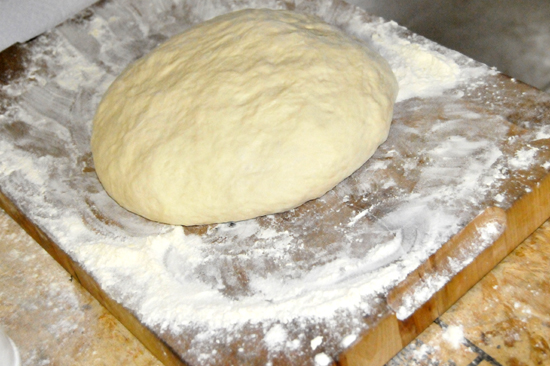Is Human Hair in Store-Bought Bread?
By: David Deschesne
Editor/Publisher,
Fort Fairfield Journal, April 13, 2016

The flour used for homemade bread dough does not contain L-cysteine, that amino acid is added by industrial bread bakers when mass-producing bread in order to help decrease the rise time by making the dough more pliable. Pictured above is the raw dough from this editor’s famous homemade bread.
photo/David Deschesne
 Is human hair in store-bought bread? Well, not exactly.
Is human hair in store-bought bread? Well, not exactly.
I was asked a few weeks ago if I had heard a derivative of human hair was being used as an ingredient in the mass-produced bread most of us buy in the grocery store. I hadn’t, but my “BS” detector started going off as I suspected it to be an internet hoax. Of course, I had to research it further.
Sure enough, typing the search string, “human hair bread” will bring up dozens of stories describing bread being made with a derivative from human hair called L-cysteine, sourced from the barber shops and mortuaries of China. Some of those stories are even from the more “establishment” news sources. Intrigued, I delved further. What I found was that the headlines were finessed quite a bit to make it sound more sensational and the stories were crafted for maximum emotional impact. I mean, how disgusting is it to consider factory bread is made with human hair as an ingredient? Now that you’ve heard the hyperbole let me help you all* understand the facts.
(*That’s “y’all,” if you’re from the South—I’ve been tapped as an ‘Honorary Southerner’ and I hear they bake pretty good bread there.)
L-cysteine
L-cysteine and its corresponding disulfide, L-cystine are non-essential amino acids that can be formed in the liver of humans as well as many mammals. L-cysteinebuilt directly from the essential amino acidL-methionine. This makes theof L-methionine in the body a critical factor to the body’s supply of-cysteine. It is therefore sometimes counted as a semi-essential amino acid and also due to its role as a catalyst in many important metabolic cycles. 1
According to the Wikipedia entry, “Although classified as a non-essential amino acid, in rare cases, cysteine may be essential for infants, the elderly, and individuals with certain metabolic disease or who suffer from malabsorption syndromes. Cysteine can usually be synthesized by the human body under normal physiological conditions if a sufficient quantity of methionine is available. Cysteine is catabolized in the gastrointestinal tract and blood plasma. In contrast, cystine travels safely through the GI tract and blood plasma and is promptly reduced to the two cysteine molecules upon cell entry. Cysteine is found in most high-protein foods, including: Animal sources: meat (including pork and poultry), eggs, dairy; Plant sources: red peppers, garlic, onions, broccoli, brussels sprout, oats, granola, wheat germ, sprouted lentils.”2
The primary industrial source of L-cysteine is goose, duck and chicken feathers; however, human hair, swine bristles, and swine hooves have also been identified as sources. These latter sources are not used in Canada.3
“Despite widespread belief otherwise, there is little evidence that human hair is used as a source material and its use is explicitly banned in the European Union. Synthetically produced L-cysteine, compliant with Jewish kosher and Muslim halal laws, is also available, albeit at a higher price. The synthetic route involves fermentation using a mutant of E. coli.”4
L-cysteine as a Health
Supplement
L-Cysteine, in supplement form, is able to fulfill several important functions in the human body due to its specific structure including sulfur and contributes significantly to the general well-being.
According to the website, www.aminoacidstudies.org, people with chronic conditions, cataract or arthritis have greatly benefited from the appropriate supplementation of this semi-essential amino acid.
“Also illnesses of the intestines usually increase the needs for L-cysteine, because many nutrients simply cannot be absorbed and get lost as a result of the digestive system being compromised. Environmental factors such as stress or extreme physical strain will also lead to an increased demand in Cysteine. L-cysteine supports the synthesis of the highly antioxidative Glutathione and can also be stored in this chemical form. It therefore plays an important part in detoxification and the resulting protection of several tissues and organs.”1
L-cysteine, along with Glutathione is also used to inhibit inflammation and strengthening the immune system as well helping to prevent dementia and multiple sclerosis. It was also shown that the supplementation of L-cysteine was able to significantly decrease the osteoporosis by reducing the activity of the osteoclasts while increasing synthesis of collagen, reversing both effects that people with Osteoporosis suffer from.
“L-cysteine is also important in the metabolism of lipids. It plays, for example, a part in building essential fatty acids and therefore enables the production of cell membranes and protective covers of nerve endings. These consist mainly of myelin, a dielectric (electrically insulating) material that forms a layer, the myelin sheath, usually around only the axon of a neuron. This protects the axon from environmental damage and attacks from free oxidative radicals. In this way L-cysteine has very high preventative potency in helping to prevent major degenerative illnesses such as Parkinson. L-cysteine can help reduce inflammation of reproductive tissues and organs. If the prostate or seminal vesicles are suffering from inflammation, fertility levels decline. The anti-oxidant effects of NAC and associated glutathione can help to alleviate inflammation, which improves fertility.”1
L-cysteine as a Bread
Dough Conditioner
In addition to being used as a health supplement, L-cysteine is also used as a dough conditioner in the industrial manufacturing of bread and bread products such as pizza dough, croissants, bagels, etc. It works by breaking the disulfide bonds of gluten, which lowers the viscosity of the dough. It is then easier to work with and increases the elasticity of the dough, helping it to rise during baking. This shortens the rise time and therefore increases productivity of the bread baking manufacturers.
L-cysteine is also used in the pharmaceutical, and personal-care industries. One of the largest applications is the production of flavors. For example, the reaction of cysteine with sugars in a Maillard reaction yields meat flavors.4
Which Bread Contains
L-cysteine?
L-cysteine is not listed as an ingredient on the bread products that contain it.
“L-cysteine, in the form of L-cysteine hydrochloride, is permitted for use in Canada in bread, flour, and whole wheat flour to a maximum level of 90 ppm. It is also allowed in un-standardized bakery products at levels that follow good manufacturing practice. [The] United States Food and Drug Administration lists L-cysteine as a GRAS substance and similar to Canada allows up to 0.009 parts per 100 parts of flour in dough as a dough strengthener.”3
A representative from Bimbo Bakeries (making such bread brands as Sarah Lee, Frierhoffer’s, and Thomas English Muffins to name a few) told me that they do use L-cysteine which is sourced from duck feathers. When I asked her the countries those duck feathers come from, she was unable to tell me because the L-cysteine is “sourced from many different suppliers worldwide.”
Looking at the other popular bread brands in this area, I checked with Flowers Foods (who make bread under the brand names, Country Kitchen, Barowsky’s, Coblestone, Nature's Own, Sunbeam, and Wonder Bread). In an e-mail conversation with Paul Baltzer, Managing Director of Media Relations and HR Communications at Flowers Foods I learned they do not use L-cysteine in any of their bread dough brands, but do use it in some of their specialty products. “Less than 1% of our products—a very limited number of specialty items, such as croissants—contain L-cysteine,” Baltzer wrote in his e-mail to me. “Most of the L-cysteine used in these products is from a synthetic source. The remainder is derived from chicken/duck feathers and approved by the FDA for use as a dough conditioner.”
Is Human Hair in Bread?
To say that L-cysteine derived from human hair is in fact in bread is a bit of a stretch. None of the stories I read online that said human hair from China was in store-bought bread offered any real, substantial and verifiable evidence to support their claim. Rather, it seems that they simply extrapolated from the facts that since L-cysteine is found in human hair, that some L-cysteine is sourced from China and that China has some very lax and oft-times questionable food preparation practices, then our bread must contain human hair-derived L-cysteine. In contemplating the “ifs,” you will see that is a lot of ifs.
Absent any whistleblower testimony, or specific L-cysteine manufacturer source documents, there simply isn’t enough evidence to state unequivocally that human hair sourced L-cysteine is in factory-made bread. Based solely upon the evidence, or lack thereof, that is common in all of those hyped-up internet stories, I doubt very much you would even be able to make a case against the bread manufacturers in court. The stories you read online simply don’t offer enough proof to support their claims.
L-cysteine from human hair is chemically the same as that derived from goose, duck or chicken feathers. While it certainly is plausible some L-cysteine used in our breads was derived from human hair, I haven’t yet found any internet blog or news article to actually offer any solid proof that it in fact is found in a specific bread product or brand.
Rather than worrying about whether the L-cysteine in their bread is derived from human hair or not, people might want to consider some of the things they are ingesting that really isn’t good for them; such as the fluoride in their municipal drinking water, the cancer-causing bromine that is added to some of the cheaper bread flours and propylene glycol which is added to many pastries, cakes and condiments. Unlike L-cysteine, which is a non-essential amino acid produced in your liver anyway, those ingredients just listed really are bad for you to begin with. Meanwhile, municipalities across the U.S.—like Fort Fairfield—are still adding fluoride to their drinking water and those other products are still being added to the processed foods found in grocery stores everywhere.
How about worrying about that?
Notes:
3. Report on L-cysteine from the Baking Association of Canada.









